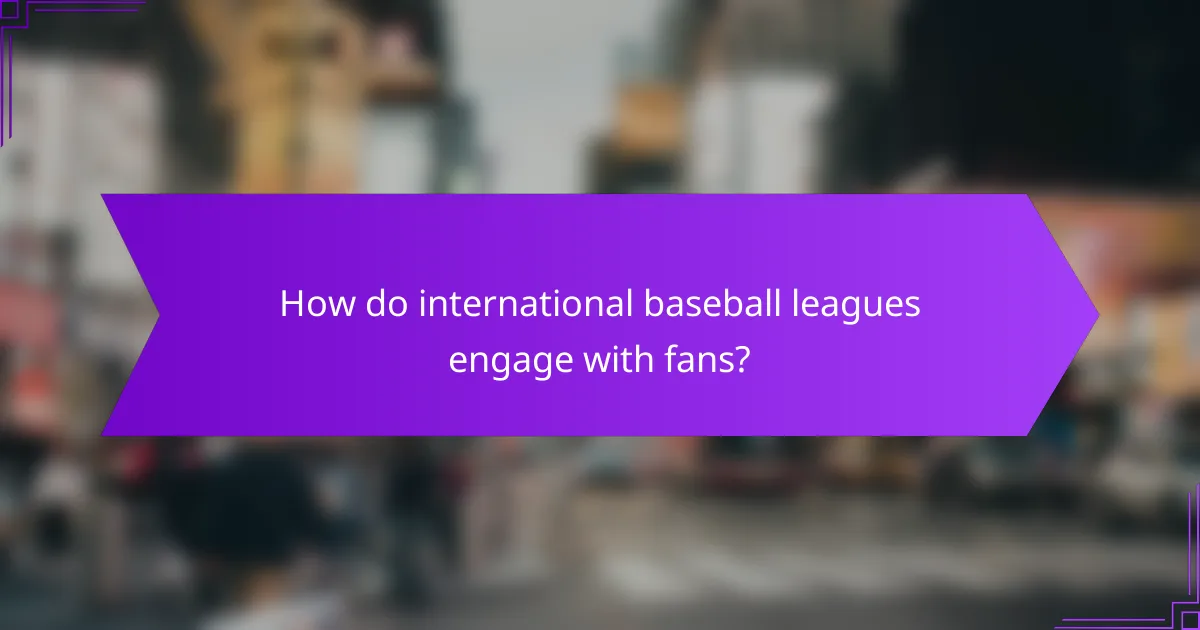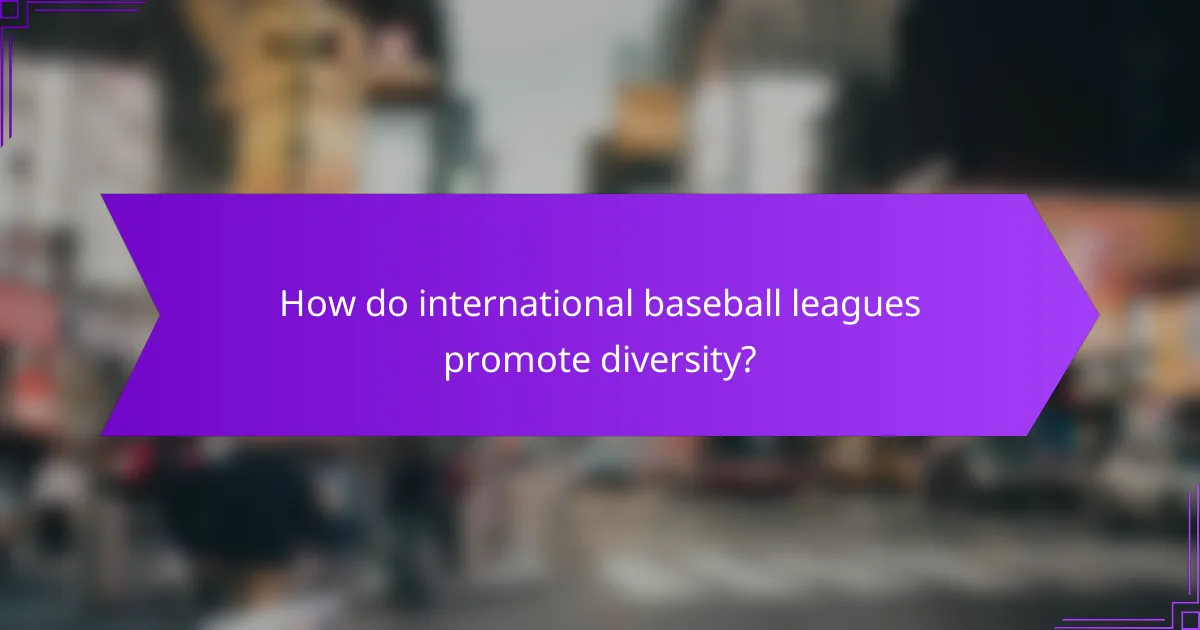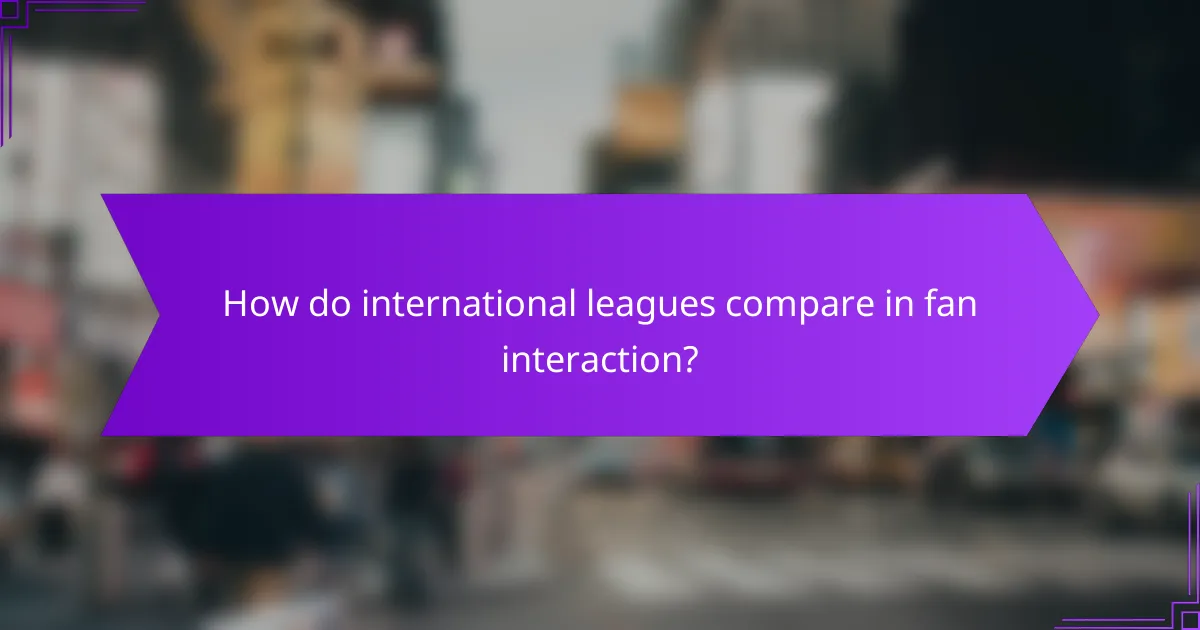International baseball leagues play a vital role in fostering cultural engagement and diversity through innovative fan interaction strategies. By utilizing social media, hosting community events, and embracing local traditions, these leagues create a unique atmosphere that enhances the spectator experience. Additionally, their commitment to inclusivity ensures representation and support for underrepresented groups, enriching the sport for players and fans alike.

How do international baseball leagues engage with fans?
International baseball leagues engage with fans through a variety of interactive methods that enhance the spectator experience and foster community. These strategies include leveraging social media, hosting fan events, providing in-game entertainment, and implementing outreach programs that connect with local communities.
Interactive social media campaigns
Social media campaigns are a powerful tool for international baseball leagues to engage fans in real-time. By utilizing platforms like Twitter, Instagram, and Facebook, teams can share highlights, behind-the-scenes content, and interactive polls that encourage fan participation.
For example, leagues often run hashtag campaigns during games, inviting fans to share their thoughts and experiences. This not only boosts engagement but also creates a sense of community among supporters across different regions.
Fan events and meet-and-greets
Fan events and meet-and-greets provide opportunities for fans to interact directly with players and team staff. These events can range from autograph sessions to special fan days at the stadium, where fans can enjoy activities and games.
Such interactions help build loyalty and deepen the connection between fans and the team. For instance, many leagues organize themed nights or community days, allowing fans to experience the game in a more personal and engaging environment.
In-game entertainment experiences
In-game entertainment experiences are designed to enhance the overall atmosphere during games. This can include live music, mascot performances, and fan contests that keep the audience engaged throughout the match.
Leagues often incorporate technology, such as mobile apps, to facilitate fan voting on in-game activities or to provide real-time updates and trivia. This interactive approach not only entertains but also encourages fans to stay connected during the game.
Community outreach programs
Community outreach programs are essential for international baseball leagues to establish a positive presence in local areas. These initiatives often focus on youth development, education, and health awareness, promoting the sport and its values.
Programs may include baseball clinics for children, partnerships with schools, and charity events that raise funds for local causes. By engaging with the community, leagues can foster goodwill and inspire the next generation of players and fans.

What cultural factors influence international baseball leagues?
Cultural factors significantly shape international baseball leagues, affecting everything from fan engagement to the overall atmosphere of the games. These influences include regional traditions, local cuisine, and expressions of national pride that create a unique experience for fans and players alike.
Regional traditions and customs
Regional traditions and customs play a vital role in how baseball is experienced around the world. For instance, in Japan, the practice of organized cheering with coordinated chants and songs enhances the game atmosphere, making it a communal event. In contrast, Latin American countries often incorporate vibrant music and dance, celebrating the sport as a cultural festival.
Understanding these customs can help teams and leagues tailor their marketing and engagement strategies to resonate with local fans. For example, incorporating local folklore or historical references in promotional materials can strengthen community ties.
Local cuisine and baseball experiences
Local cuisine significantly enriches the baseball experience, with many fans enjoying traditional foods while watching games. In the United States, classic ballpark fare includes hot dogs and peanuts, while in South Korea, fans might savor fried chicken and beer during matches. This culinary aspect not only enhances enjoyment but also reflects local culture.
Teams can capitalize on this by offering region-specific food options at stadiums, creating a more immersive experience. For instance, a team in Mexico might serve tacos and tamales, appealing to local tastes and encouraging fans to enjoy the game in a culturally relevant way.
National pride and identity
National pride and identity are often intertwined with baseball, influencing how fans support their teams. In countries like Cuba and the Dominican Republic, baseball is a source of national pride, with players often viewed as national heroes. This deep connection can lead to passionate fan engagement and loyalty.
Leagues can harness this sense of identity by promoting local players and celebrating national achievements. For example, hosting events that honor historical milestones in baseball can strengthen the bond between the sport and national pride, encouraging greater fan participation and support.

How do international baseball leagues promote diversity?
International baseball leagues promote diversity by implementing inclusive practices that welcome players from various backgrounds, ensuring representation in marketing efforts, and supporting community programs aimed at underrepresented groups. These initiatives create a more vibrant and inclusive environment within the sport.
Inclusive player recruitment practices
International baseball leagues often adopt inclusive player recruitment practices to attract talent from diverse backgrounds. This may involve scouting in various regions, including those traditionally underrepresented in the sport, and hosting open tryouts that encourage participation from all demographics.
Leagues may also partner with local organizations to identify promising players from different communities, ensuring that recruitment efforts reflect the diversity of the fan base. By prioritizing inclusivity, leagues can enhance their talent pool and foster a richer cultural exchange within the sport.
Diverse representation in marketing
Diverse representation in marketing is crucial for international baseball leagues to connect with a broad audience. This includes featuring players from various ethnicities and backgrounds in promotional materials, advertisements, and social media campaigns, which helps to resonate with fans from different cultures.
Leagues can also collaborate with multicultural agencies to create targeted marketing strategies that reflect the interests and values of diverse communities. By showcasing a variety of voices and stories, leagues can build stronger relationships with their fan base and promote a sense of belonging.
Community programs supporting underrepresented groups
Community programs play a vital role in supporting underrepresented groups within international baseball leagues. These initiatives often focus on youth engagement, providing access to baseball training, mentorship, and resources for aspiring players from diverse backgrounds.
Leagues may establish partnerships with schools and local organizations to create outreach programs that promote inclusivity and participation in the sport. By investing in these community efforts, leagues not only nurture future talent but also foster a more diverse and engaged fan base.

What are the key challenges faced by international baseball leagues?
International baseball leagues encounter several challenges, including cultural barriers, economic disparities, and competition from other sports. Addressing these issues is crucial for enhancing fan engagement and promoting the sport globally.
Cultural barriers to fan engagement
Cultural differences can significantly impact how fans engage with baseball. For instance, in regions where baseball is not a traditional sport, such as parts of Europe, fans may not understand the game’s nuances or its significance, leading to lower attendance and participation.
Leagues must adapt their marketing strategies to resonate with local cultures. This could involve incorporating local languages, traditions, and values into promotional materials and game-day experiences to foster a deeper connection with potential fans.
Economic disparities across regions
Economic conditions vary widely across countries, affecting the financial viability of international baseball leagues. In wealthier regions, teams may attract sponsorships and higher ticket prices, while in developing areas, lower disposable income can limit fan spending.
To bridge this gap, leagues can implement tiered pricing strategies, offering affordable ticket options and merchandise to engage a broader audience. Additionally, partnerships with local businesses can enhance financial support and community involvement.
Competition from other sports
Baseball faces stiff competition from other popular sports, such as soccer and basketball, which often dominate media coverage and fan interest. This rivalry can dilute baseball’s visibility and appeal, especially in markets where these sports are deeply entrenched.
To combat this, leagues should focus on unique selling points of baseball, such as its rich history and community-oriented events. Engaging younger audiences through social media and interactive experiences can also help attract new fans and retain existing ones.

How do international leagues compare in fan interaction?
International baseball leagues engage fans through various strategies, with differing levels of interaction and cultural integration. While Major League Baseball (MLB) emphasizes digital engagement and community outreach, leagues like Nippon Professional Baseball (NPB) focus on traditional fan experiences and local culture.
Major League Baseball vs. Nippon Professional Baseball
Major League Baseball (MLB) utilizes advanced technology and social media to enhance fan interaction, offering apps for real-time updates and virtual experiences. Fans can participate in polls, contests, and live chats, creating a dynamic online community.
In contrast, Nippon Professional Baseball (NPB) fosters a more traditional atmosphere, emphasizing in-person experiences. Fans often engage through organized cheering sections and rituals, creating a unique game-day culture that celebrates local traditions and team loyalty.
Mexican League fan engagement strategies
The Mexican League employs a variety of fan engagement strategies, including affordable ticket pricing and family-friendly events. Teams often host themed nights, where fans can enjoy special promotions and activities that enhance the overall experience.
Additionally, the league actively promotes local culture through music and food at games, making the ballpark a community hub. This approach not only attracts diverse audiences but also strengthens the bond between teams and their local fan bases.
Caribbean Series cultural impact
The Caribbean Series serves as a significant cultural event, showcasing the diversity of baseball across the region. It brings together teams from various countries, allowing fans to experience different cultural expressions through music, food, and traditions.
This series promotes cross-cultural interaction and fosters a sense of unity among fans from different backgrounds. The celebration of regional pride and shared love for the sport enhances the overall cultural impact, making it a key event in the baseball calendar.

What role do sponsorships play in international baseball leagues?
Sponsorships are crucial in international baseball leagues as they provide financial support and enhance the overall experience for fans. These partnerships can lead to increased visibility for brands while simultaneously boosting the league’s revenue and engagement with its audience.
Brand partnerships enhancing fan experiences
Brand partnerships in international baseball leagues often focus on creating memorable experiences for fans. For instance, sponsors may host special events, offer exclusive merchandise, or provide unique access to players and games. This not only strengthens the connection between fans and the sport but also elevates the brand’s presence in the community.
Moreover, sponsors can engage fans through interactive promotions, such as contests or social media campaigns, that encourage participation and build excitement around games. These initiatives can lead to increased attendance and a more vibrant atmosphere at stadiums.
Brands can also leverage technology to enhance fan experiences, such as mobile apps that offer real-time updates, rewards for attending games, or augmented reality features that provide deeper insights into player statistics and game strategies. This integration of technology not only enriches the fan experience but also aligns the brand with innovation and modernity.



